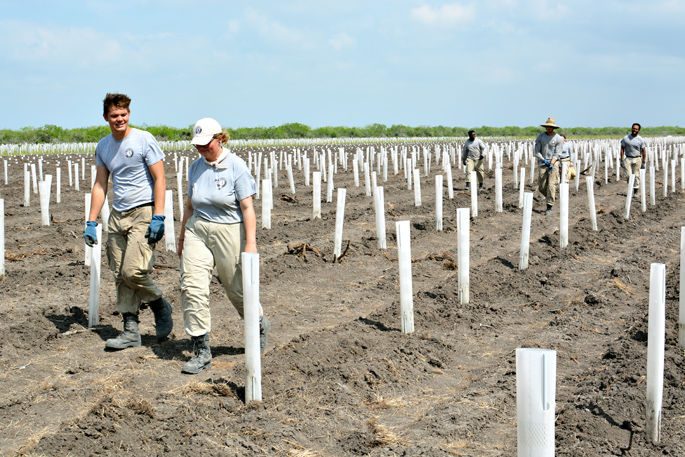LOS FRESNOS — What was once a plot of land is turning into a plantation.
Building on the success of a 34-acre planting at Laguna Atascosa National Wildlife Refuge last year, U.S. Fish and Wildlife officials are back again with another 34-acre plot as they continue to restore native Tamaulipan thorn scrub for ocelot habitat.
“We wanted to plant it earlier in the year but we weren’t able to get out here as soon as I had hoped, so it’s a little bit on the tail end of our planting season,” said Kim Wahl, plant biologist with the U.S. Fish and Wildlife Service.
“But other than that, it’s getting a great planting crew, it’s getting the tree protectors, it’s getting initial watering and then it will get grass control afterwards,” she added, “so it’s getting everything that we can give it to give that high success rate.”
Last year, using innovative white plastic tree tubes to protect delicate seedlings from browsing animals like white-tailed deer and nilgai, the planting recorded a survival rate of 93 percent. Successful reforestation efforts without the tubes can be as low as 20 percent, or even zero percent.
Back to the past
The goal of the restoration efforts is to remove the dominant mesquite and non-native guinea grass to replicate the variety of fauna found in the Rio Grande Valley prior to the advent of major agricultural production in the early 1900s.
Beneficiaries will be the endangered Texas subspecies of ocelot, along with hundreds of other mammal, reptile and bird species in the RGV.
Some of the 34,000 native plants to be sown here on the second 34-acre plot, like snake eyes or devil queen, Texas torchwood, crucita, trixis, lantana, Berlandier croton and Manzanita, are benefiting from another innovative planting/protection method called a cocoon.
Wahl said the “cocoon” is made of biodegradable material and is buried about 3 feet underground. And while she concedes this is a more labor-intensive method than even the tree tubes, it could have remarkable benefits to enable a plant to thrive in the event of drought.
“They’re buried underground, filled with water, and then covered back with soil,” Wahl said last week as she stood in a field of white plastic tubes. “What that’s supposed to do is, the plant is planted in the middle and then the perimeter is filled with water.
“There are two cloth wicks that go into where the plant is planted at and that’s supposed to wick moisture to the roots as needed, for about three months,” she added. “And then depending on what the conditions are, the water will be used up, and then it will start to biodegrade and sink in, and create a little divot around the plants to catch water in the future.”
An estimated 95 percent of the native Tamaulipan thorn scrub has been cleared for farming over the past century. The vegetation is characterized by dense brush, cactus and a mix of tree species unique to Texas among U.S. states.
Accelerating native plants to maturity is a key part of the mission since traditional habitat restoration of Tamaulipan thorn scrub has shown a plot can take more than 20 years to fully mature.
Wahl said they will assess the performance of the cocoons, and determine whether it helps with root development and speeds the plants to maturity and seed production more quickly.
“So we’re testing that out, and we’re continuing to deal with our tried-and-true” tree protectors, she said.
Volunteers out in force
Wahl and her USFWS crew are thankful for an outpouring of volunteers who have arrived to help with putting the native plants in the ground.
“On Saturday (March 10), we had 91 volunteers on that volunteer day, which was excellent,” she said.
Last week Wahl and her crew could also count on a 10-person AmeriCorps crew which was helping with the habitat restoration.
“I love it — it’s beautiful here at Laguna,” said Arianna Brady of Scranton, Pennsylvania, the youthful AmeriCorps crew leader. “It’s definitely a great site to be working on.”
Laguna Atascosa’s lead ranger, Marion Mason, said there’s still room for volunteers on the site in case anyone wants to contribute to a project which will endure for decades or even longer.
“We invite volunteers to come out and plant seedlings, Monday through Friday, between 8 and 4,” Mason said. “Whether it’s one hour or eight hours, any help is appreciated, and that will be ongoing until noon on the 28th of March.
“This is probably the single best thing that people can do to help wildlife,” Mason added. “Not only is it going to establish habitat for ocelots, but there are hundreds of other species that will use that area as well.”
What’s being planted
Snake eyes or devil queen
Texas torchwood
Crucita or Christmas bush
Trixis or American threefold
Lantana
Berlandier croton
Manzanita or Barbados cherry
Total to be planted: 34,000




